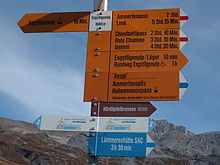
The Czech Republic, also known as Czechia, is a landlocked country in Central Europe. Historically known as Bohemia, it is bordered by Austria to the south, Germany to the west, Poland to the northeast, and Slovakia to the southeast. The Czech Republic has a hilly landscape that covers an area of 78,871 square kilometers (30,452 sq mi) with a mostly temperate continental and oceanic climate. The capital and largest city is Prague; other major cities and urban areas include Brno, Ostrava, Plzeň and Liberec.

The Army of the Czech Republic, also known as the Czech Army, is the military service responsible for the defence of the Czech Republic as part of the Armed Forces of the Czech Republic alongside the Military Office of the President of the Republic and the Castle Guard. The Army consists of the General Staff, the Land Forces, the Air Force and support units.

The Tatra Mountains, Tatras, or Tatra, are a series of mountains within the Western Carpathians that form a natural border between Slovakia and Poland. They are the highest mountains in the Carpathians. The Tatras are distinct from the Low Tatras, a separate Slovak mountain range further south.

The South Bohemian Region is an administrative unit (kraj) of the Czech Republic, located mostly in the southern part of its historical land of Bohemia, with a small part in southwestern Moravia. The western part of the South Bohemian Region is former Prácheňsko, a huge archaic region with distinctive features with its capital, Písek. In 2011, there were 624 municipalities in the region, whereof 54 had a status of a town.

The Low Tatras or Low Tatra is a mountain range of the Inner Western Carpathians in central Slovakia.

Špindlerův Mlýn is a town in Trutnov District in the Hradec Králové Region of the Czech Republic. It has about 1,100 inhabitants. It lies in the Giant Mountains and it is one of the most frequented ski resorts in the country.

Trail blazing or way marking is the practice of marking paths in outdoor recreational areas with signs or markings that follow each other at certain, though not necessarily exactly defined, distances and mark the direction of the trail.

Kriváň is a mountain in the High Tatras, Slovakia, that dominates the upper part of the former Liptov County. Multiple surveys among nature lovers have ranked it as the country's most beautiful peak. Readily accessible along maintained marked trails and with the exceptional vistas afforded from its summit, it is the hikers' favorite mountain in the western part of the High Tatras. Kriváň has also been a major symbol in Slovak ethnic and national activism for the past two centuries. It has been referenced in works of art from 19th-century literature, through paintings, film documentaries, to a Polish rock track. A country-wide vote in 2005 selected it to be one of the images on Slovakia's euro coins.

Veľká Fatra is a mountain range in the Western Carpathians in Slovakia. The Veľká Fatra lie to the southeast of the better known Malá (Lesser) Fatra mountains and are less developed, as well as being lower.

The DANA (Dělo automobilní nabíjené automaticky is a wheeled self-propelled artillery piece. It is also known as the Samohybná Kanónová Húfnica vzor 77. It was designed by Konštrukta Trenčín and built by ZTS Dubnica nad Váhom in the former Czechoslovakia. Introduced in the 1970s, it was the first wheeled 152 mm self-propelled artillery gun to enter service. It is based on a modified eight-wheel drive Tatra 815 chassis with excellent cross-country mobility. Currently it is in service with the Czech Republic, Libya, Poland, Georgia, Azerbaijan, Slovakia, and Ukraine.

The RM-70 multiple rocket launcher is a Czechoslovak Army version and heavier variant of the BM-21 Grad multiple rocket launcher, providing enhanced performance over its parent area-saturation rocket artillery system that was introduced in 1971.
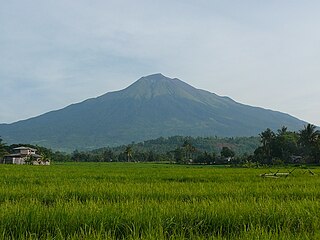
Kanlaon, also known as Mount Kanlaon and Kanlaon Volcano, is an active stratovolcano and the highest mountain on the island of Negros in the Philippines, as well as the highest point in the Visayas, with an elevation of 2,465 m (8,087 ft) above sea level. Mount Kanlaon ranks as the 42nd-highest peak of an island in the world.
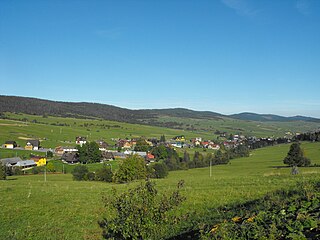
Ždiar is a village and municipality in the Poprad District in the Prešov Region in Spiš in northern Slovakia.
Pavčina Lehota is a village and municipality in Liptovský Mikuláš District in the Žilina Region of northern Slovakia. The village is known mainly for tourism because of its location among the famous attractions of large caves, aqua parks, ski resorts that surrounds the village.
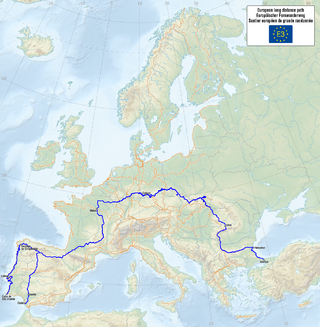
The E3 European long distance path, or just E3 path, is a 6,950-kilometre (4,320 mi) long-distance footpath that is planned to run from the Portuguese coast to the Black Sea in Bulgaria. It is one of the network of European long-distance paths.
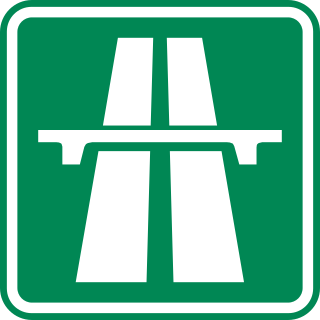
Highways in the Czech Republic are managed by the state-owned Directorate of Highways and Motorways of the Czech Republic – ŘSD ČR. The ŘSD currently manages and maintains 1,355 km of motorways (dálnice) and the national speed limit is 130 km/h with an expectation that limit will be increased for some sections to 150 km/h (93 mph). The length of the motorway network is planned to be expanded to 2,000 km by 2030.

Rail transport in the Czech Republic carried 193.5 million passengers in 2019, and 68.37 million tonnes of cargo in the year 2009. The majority of passenger services run nowadays are operated by the state company České dráhy, which until 2007 also managed cargo services now run by ČD Cargo. In 2009 the country had 9,420 km of standard gauge track, 3,153 km of which is electrified. There are two main electrification systems in the Czech Republic, 3 kV DC in the northern part, and 25 kV 50 Hz AC in the south. Locomotives had to be changed on boundaries in the past, two-system locomotives have been introduced in 1974. The network has same gauge links to all four countries bordering the Czech Republic with passenger services to all four countries in operation. Major hubs for international passenger services on the network are in Prague, Ostrava, Brno and Břeclav, and the busiest station is Praha hlavní nádraží. Maximum speed on Czech rails is 160 km/h (99mph).

Volovec or Wołowiec is a mountain in the Western Tatras at the border of Slovakia and Poland. It lies on the main ridge of Western Tatras between Ostrý Roháč and mountain Deravá, standing over three valleys: Chochołowską, Roháčska and Jamnícka.
AURES Holdings, a.s., runs the AAA AUTO used car outlets in the Czech Republic, where most of its business is located. It also has branches in Slovakia, Hungary and Poland. The firm has branches in 22 cities in the Czech Republic, 14 in Slovakia, 1 in Hungary and 11 in Poland. In September 2017, it recorded its two millionth customer.







